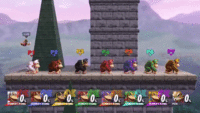From SmashWiki, the Super Smash Bros. wiki
Jump to navigationJump to search
| Display title | Stale-move negation |
| Default sort key | Stale-move negation |
| Page length (in bytes) | 21,365 |
| Page ID | 1412 |
| Page content language | en - English |
| Page content model | wikitext |
| Indexing by robots | Allowed |
| Number of redirects to this page | 11 |
| Counted as a content page | Yes |
| Number of subpages of this page | 0 (0 redirects; 0 non-redirects) |
| Page image |  |
| Edit | No extra protection (infinite) |
| Move | No extra protection (infinite) |
View the protection log for this page.
| Page creator | smashwikia>Brawlmatt202 |
| Date of page creation | 17:57, February 11, 2008 |
| Latest editor | Alex the weeb (talk | contribs) |
| Date of latest edit | 18:20, January 27, 2025 |
| Total number of edits | 325 |
| Recent number of edits (within past 90 days) | 2 |
| Recent number of distinct authors | 2 |
| Meta categories (2) | This page is a member of 2 meta categories:
|
| Transcluded templates (15) | Templates used on this page:
|
Description | Content |
Article description: (description)
This attribute controls the content of the description and og:description elements. | Stale-move negation, known as Repetition Effect in Super Smash Bros. 4 and Stale Moves in Super Smash Bros. Ultimate, is a mechanic and a gameplay element in all games in the Super Smash Bros. series. It refers to how moves cause less damage and... |
Information from
Extension:WikiSEO
